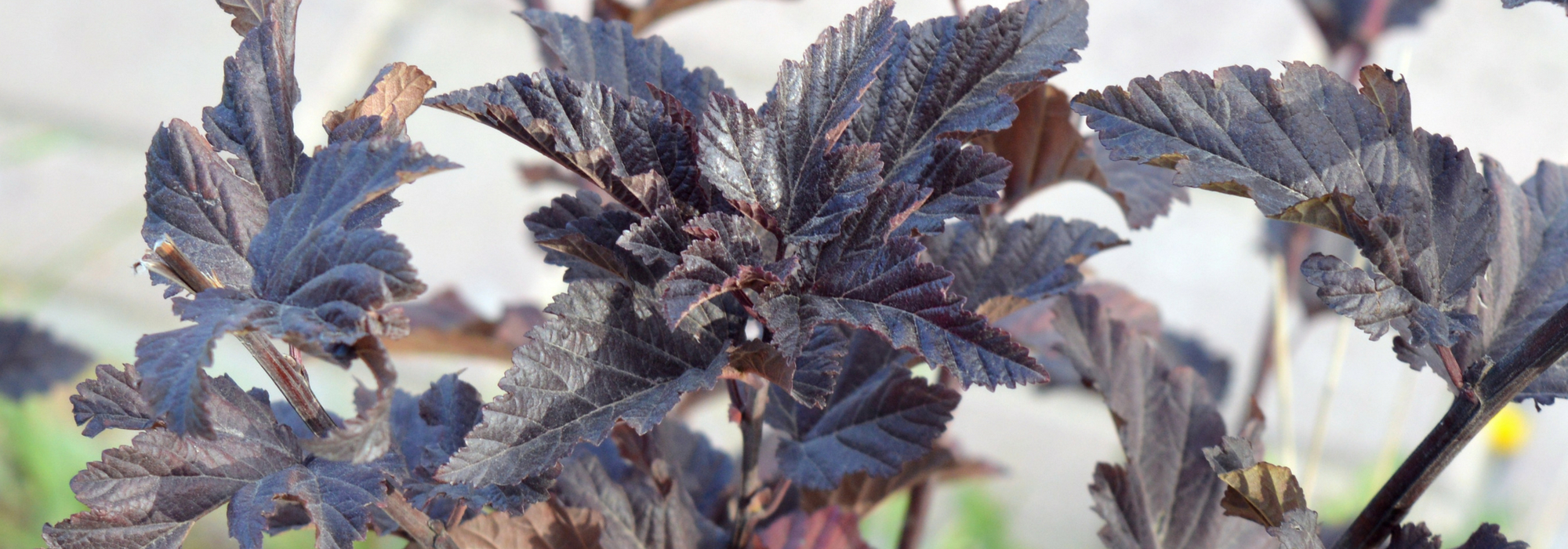
Physocarpus, Physocarpus with elder-like leaves: plant, prune and care
Contents
Physocarpus, in a nutshell
- Physocarpus are small bushy plants with a rustic appearance, featuring arching branches that reach 1 to 2 m in height depending on the cultivars.
- The deciduous foliage, coloured in purple, orange, or gold depending on the varieties, brightens up the beds throughout the beautiful season, accompanied by small clusters of pale pink flowers in June-July.
- The reddish fruits, with yellow seeds, resemble swollen pods that create a striking effect in autumn when the foliage turns bright yellow.
- These hardy and easy-going bushes are perfect for beginner gardeners: they thrive in cool soil, withstand occasional droughts, and require little pruning.
- They are well-suited for small gardens as solitary specimens, in hedges, or in borders.
A word from our expert
Physocarpus or Ninebark is a graceful bush that is very hardy and accessible to any gardener. The trilobed leaves with prominent veins, borne on bright red stems, brilliantly illuminate the garden at the awakening of spring with lovely colours of purple-red or golden yellow. The flowering in pinkish-white corymbs adds embellishments between May and July. Autumn marks the crowning of this bush with the flaming of the foliage accompanied by brilliant fruiting.
It enjoys a rich, rather acidic, well-drained and cool summer soil and is suitable for full sun as long as the soil remains cool in summer or partial shade. It integrates easily into a wild hedge that will please both pollinating insects and birds fond of its fruits, as well as in an urban setting. The compact forms with spectacular hues grow very well in pots or in a small garden alongside perennials or other bushes, offering interest throughout the year.

Beautiful corymb inflorescence of a Physocarpus.
Canadians refer to it as “wood of seven barks” due to the layering of the bark in thin plates of older specimens. This characteristic must have caught the attention of Indigenous peoples who used the inner bark of Physocarpus for its medicinal properties as a purgative, emetic, and anti-bacterium. However, this character is not the main asset of this North American bush that has been revived in recent years. There are forms for all tastes, from majestic large bushes reaching nearly 3 m high to smaller ones barely exceeding a metre, with golden-green foliage to brighten up the beds, purple-red bronze to almost black to play with the rays of light.
Description and botany
Botanical data
- Latin name Physocarpus opulifolius
- Family Rosaceae
- Common name Ninebark
- Flowering between May and July
- Height between 1.20 m and 3 m
- Exposure full sun or partial shade
- Soil type cool, deep, well-drained, rather acidic and fairly rich
- Hardiness Excellent (-30°C)
The genus Physocarpus belongs to the family Rosaceae, just like hawthorn or spiraea, but it is unique in forming very decorative swollen follicles after flowering. It was named Neillia, Opulaster, and Spiraea, particularly when Carl von Linné classified it in 1793. The genus, primarily native to North America, includes about ten species of bushes, one of which is native to Southeast Asia. The most cultivated is Physocarpus opulifolius, found in the northeastern quarter of the United States from Quebec to Virginia and from Michigan to Tennessee. It grows in sandy or rocky areas up to 1500 m in altitude.
The Ninebark reaches 1.50 m to 3 m in all directions in the wild, with a bushy, well-branched habit, tending to sucker. The initially upright branches arch with age, giving a graceful, very natural appearance to the bush.
The typical species has trilobed and serratifoliate leaves that resemble those of the viburnum, with a bright yellow-green hue. They are deciduous, alternate, with well-marked veins, measuring between 5 and 8 cm long. Other species have more dissected leaves, such as monogynus, deeply lobed, sticky and villous in capitatus. The cultivars of P. opulifolius are distinguished by the beauty of their foliage colours, which can change, for example, from almost fluorescent golden yellow in spring to lime green, then to coppery yellow in autumn in ‘Dart’s Gold’, or from purple-red to dark purple appearing almost black in summer before igniting in orange and coppery pink in autumn in ‘Diabolo’.
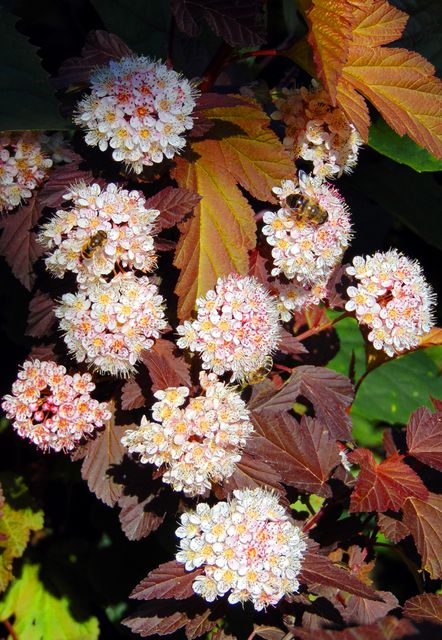
Stunning flowering of Physocarpus ‘Diable d’Or’ (PAP).
The bark is remarkable, exfoliating in several thick layers of beige, ochre to reddish-brown, similar to eucalyptus, which has earned it the Canadian name “wood of seven barks”. The young shoots, slightly reddish, are striate. These adopt more vibrant hues, mahogany or bright red in the cultivars.
The flowers, measuring half a centimetre, appear between May and July in the form of rounded white corymbs tinged with pink, 4-5 cm in diameter, contrasting with the foliage. The flowering resembles that of spiraea, with its pink conical buds that unfold into five rounded petals. The yellow centre of the corolla hosts a multitude of stamen with sparkling orange anthers. They are very nectariferous.
They are followed by clusters of small shiny raspberry follicles that burst when pressed, revealing yellow seeds, which are appreciated by birds. The fruits remain part of the winter, eventually turning black.
The name Physocarpus opulifolia comes from the Greek ‘phusa’, meaning air bubble or vesicle, and ‘karpos’, meaning fruit, referring to the shape of the fruit. Its leaf resemblance to that of the viburnum has earned it the specific name “opulifolius”. Introduced to Europe around 1687, the numerous vibrant cultivars created in recent years have led to a resurgence of Ninebark in gardens.
In the language of flowers, Physocarpus symbolizes pretension, opulence, and wealth, which clearly reflects the generosity of its flowering enhanced by the profusion of its dentate foliage.

Several colours of foliage: Physocarpus ‘Midnight’, Physocarpus ‘Anny’s Gold’, Physocarpus ‘Diable d’Or’ (PAP), Physocarpus ‘Angel Gold’ (Denolf).
The main varieties of Physocarpus
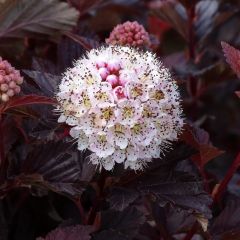
Physocarpus opulifolius Lady in Red - Ninebark
- Flowering time June to August
- Height at maturity 1,50 m

Physocarpus opulifolius Amber Jubilee - Ninebark
- Flowering time June to August
- Height at maturity 1,50 m

Physocarpus opulifolius Little Devil - Ninebark
- Flowering time June to August
- Height at maturity 1 m
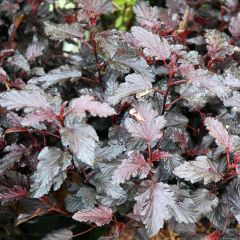
Physocarpus opulifolius All Black - Ninebark
- Flowering time June, July
- Height at maturity 1,50 m
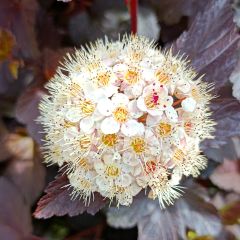
Physocarpus opulifolius Diabolo - Ninebark
- Flowering time June to August
- Height at maturity 2 m
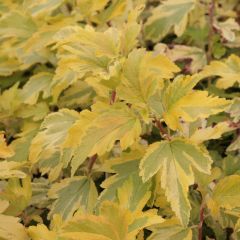
Physocarpus opulifolius Annys Gold - Ninebark
- Flowering time June, July
- Height at maturity 1,75 m
Physocarpus opulifolius Angel Gold
- Flowering time June, July
- Height at maturity 2 m
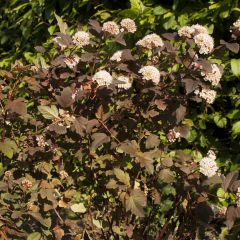
Physocarpus opulifolius Diable D'Or - Ninebark
- Flowering time June, July
- Height at maturity 2 m
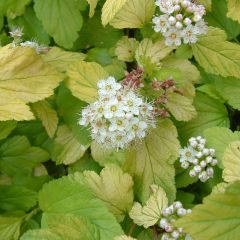
Physocarpus opulifolius Darts Gold - Ninebark
- Flowering time June, July
- Height at maturity 2 m
Discover other Physocarpus
View all →Available in 0 sizes
Available in 3 sizes
Available in 1 sizes
Available in 1 sizes
Available in 4 sizes
Available in 2 sizes
Available in 2 sizes
Available in 2 sizes
Available in 1 sizes
Available in 1 sizes
Where, when, and how to plant a physocarpus
Where to plant Physocarpus?
Due to their extreme hardiness, you can plant Physocarpus anywhere in France, provided you give it a cool spot in summer and shelter it from drying winds.
Offer it a deep, humus-bearing, rich, and cool but well-drained, acid to neutral soil. It can, however, tolerate heavy and slightly calcareous soil.
This bush will thrive in partial shade or full sun depending on the climate, knowing that golden or variegated foliage may be damaged by too much sun exposure.
The bush remains decorative in winter, with its bark exfoliating in beige to reddish-brown plates. Plant it in a location that allows you to enjoy it throughout the year.
When to plant?
Physocarpus is a perfectly hardy shrub that is not afraid of late frosts, so it can be planted from November to March when it has bare roots (in the absence of leaves). However, avoid planting during frost periods. In containers, the plant can be planted at any time of the year, but ideally, it is best to avoid periods of intense heat or flowering.
How to plant?
Observe a planting distance of 1 m for low-vigor varieties and 2 m for others. Within a hedge, you can reduce the distance to 1.5 m.
- Soak the root ball in a bucket of water to thoroughly moisten it.
- Dig a planting hole 50 cm in all directions.
- Add a 10 cm drainage layer (gravel, sand…) if your soil is clayey.
- Add well-rotted manure or compost.
- Place the plant in the planting hole.
- Replace the soil and lightly firm it down.
- Water.
- Spread a layer of mulch at the base to maintain good moisture around the roots. This will also limit the growth of weeds.
The recovery is easy and quick and requires little maintenance.
For container cultivation, place a 3-4 cm drainage layer at the bottom of the pot (gravel, broken pottery, etc.). Add a mix consisting of 1/3 soil, 1/3 potting soil, and 1/3 coarse sand. Add mulch to maintain moisture (B.R.F, lin flakes, cocoa shells…)
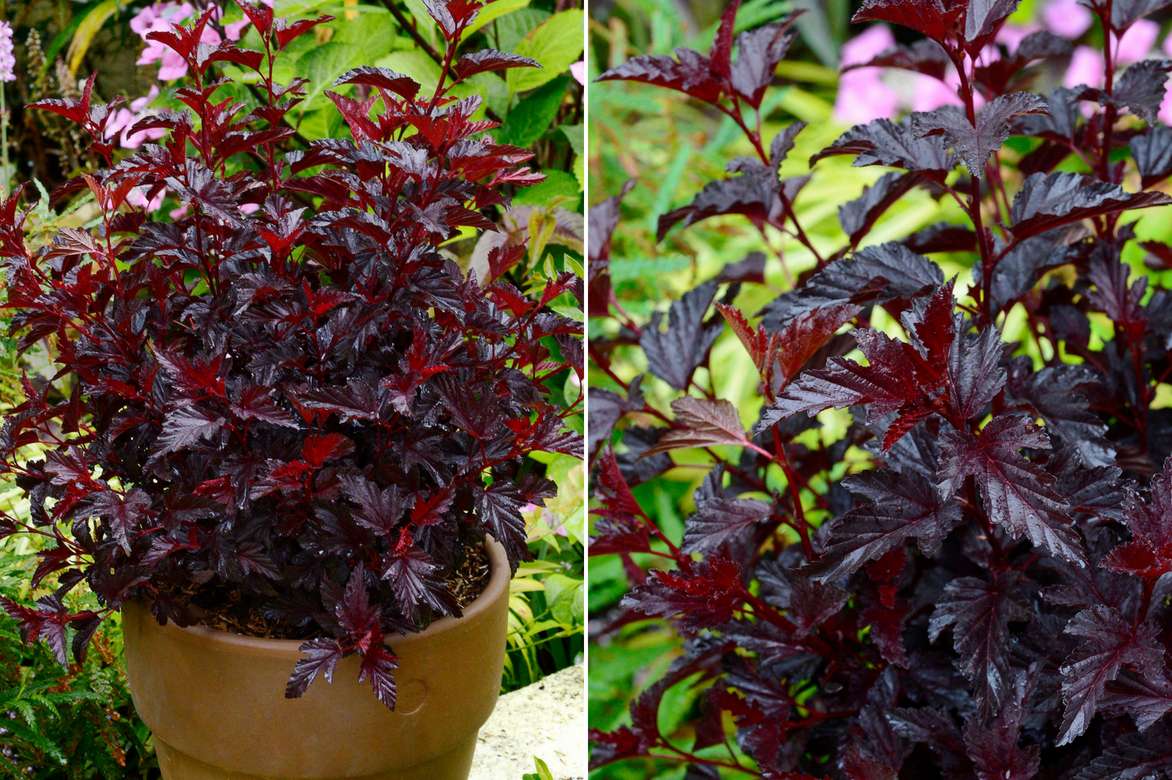
The Physocarpus ‘All Black’ is well-suited for pot cultivation.
Read also
Photinia: planting, pruning and careCare and pruning of Physocarpus
Keep the soil cool by mulching during summer or plant ground cover plants at its base and water the soil deeply from time to time. In the evenings of hot days, mist the foliage.
Pruning is not essential but you can severely cut back the arching branches to aerate the clump after flowering and encourage the emergence of new flower buds in late summer. The shoots of compact varieties can be reduced by one-third after flowering, but you will not be able to enjoy the fruits.
Keeping old branches allows you to appreciate the cinnamon-coloured bark. It is possible to cut back the bush to 30 cm from the ground if you wish to make the base bushier and prevent it from spreading by producing numerous suckers at the expense of the mother plant.
Multiplication: cutting
The Physocarpus propagates easily in August using semi-lignified shoots. Sowing is possible but does not produce plants identical to the mother plant.

Fruiting of Physocarpus ‘Lady in Red’.
Propagation by Cuttings
To propagate your physocarpus, prepare a pot deep by filling it with potting soil mixed with sand, or carry out your cuttings in the ground if it is light, after aerating it with a fork, then moistening it.
- Take a lignified shoot 10 cm long from a shoot of the year that is still green but hardened at the base.
- Remove the leaves near the base of the cutting, and trim the others to reduce the leaf surface.
- Insert the cuttings two-thirds of their height, ensuring they do not touch each other.
- Gently firm the soil around to eliminate air pockets and ensure good contact between the potting soil and the cutting.
- Place them in a humid environment in the shade, for example, by covering them with a cut transparent plastic bottle.
- Towards the end of September, remove the bottle and place the cuttings under a frame until spring.
- Separate the rooted cuttings in spring to plant them in individual pots until the following autumn.
Using and Combining Physocarpus in the Garden
Physocarpus forms very attractive medium-sized free hedges between 1.5 m and 2 m high. To create a rustic effect, pair it with Amelanchier, the viburnum sargentii ‘Onondaga’, with its lovely trilobed foliage that flowers just before, the winged euonymus (Euonymus alatus), hawthorn, or even the elder Sambucus nigra ‘Sérénade’, whose foliage colour also changes with the seasons…

An idea for a planting combination: Physocarpus ‘Diabolo’ (FD Richards), Centranthus ruber (Snapp3r), Allium ‘Globemaster’, a sage like the stunning Salvia nemorosa ‘Caradonna’, Penstemon barbatus ‘Coccineus’.
Medium and low vigour varieties will form charming small free hedges, alongside spireas (Spirea arguta, Spirea x billardii), viburnums (Viburnum carlesii ‘Chesapeake’, Viburnum x bodnantense), dwarf winged euonymus (Euonymus alatus ‘Compactus’) or a Neillia affinis… To accompany the changing colours of the Physocarpus, you can plant perennials at the base such as Heucheras or Heucherellas, or even a Cerastostigma plumbaginoides with its small electric blue flowers in summer and autumn.

A beautiful idea for a combination between the purple foliage of Physocarpus opulifolius ‘Diable d’Or’ and the pink inflorescences of Hydrangea arborescens ‘Invincibelle’.
Use golden-leaved cultivars such as ‘Angel Gold’ to brighten a semi-shaded bed or to contrast with the orange-purple foliage of Berberis thunbergii ‘Admiration’, the dark foliage of black elder ‘Black Lace’ or Physocarpus ‘Lady in Red’ or ‘All Black’. Purple varieties will work wonderfully to highlight the light blooms of perennials planted in front or the golden foliage of Euonymus japonicus ‘Aureovariegata’, Leycesteria formosa ‘Golden Lanterns’ or the silvery foliage of shrubby wormwoods or dwarf willows (Salix subopposita, lanata).
→ read on for more inspiration: “Physocarpus: 5 ideas for pairing it in the garden“
- Subscribe!
- Contents
































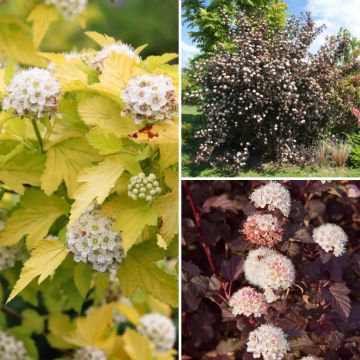


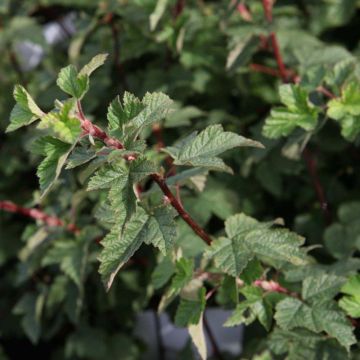

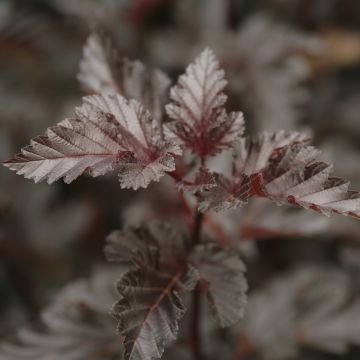
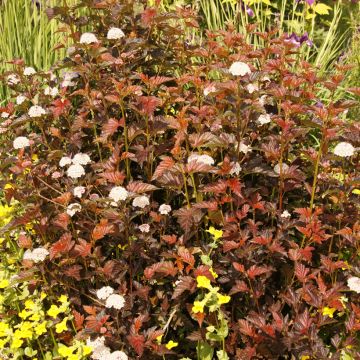
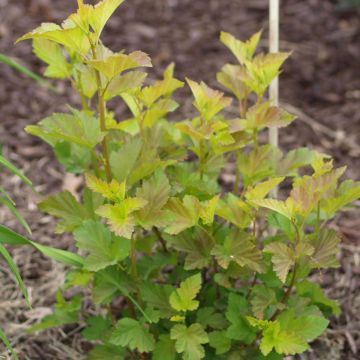
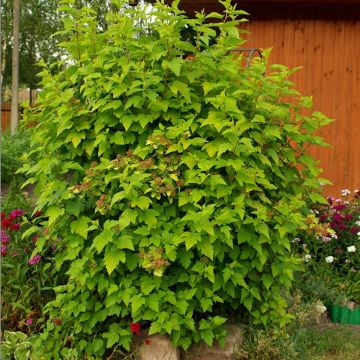
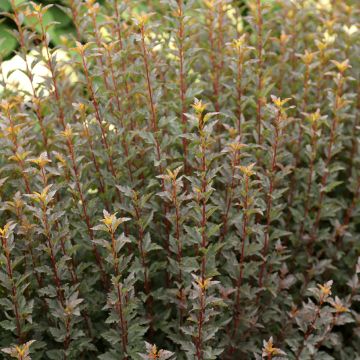
Comments